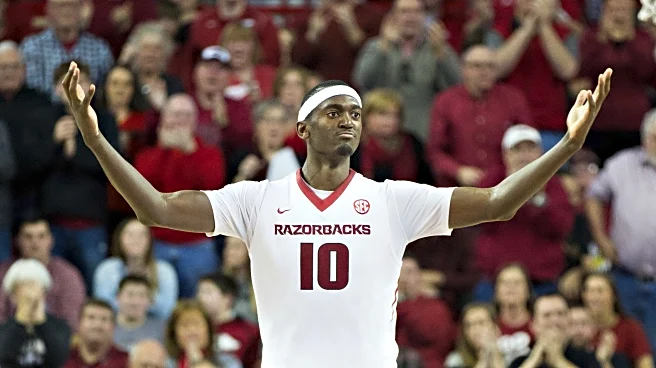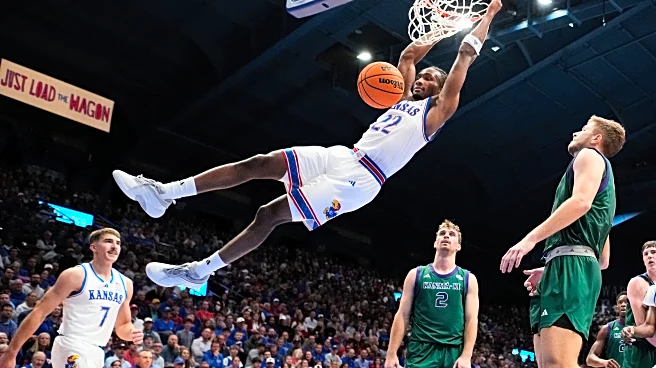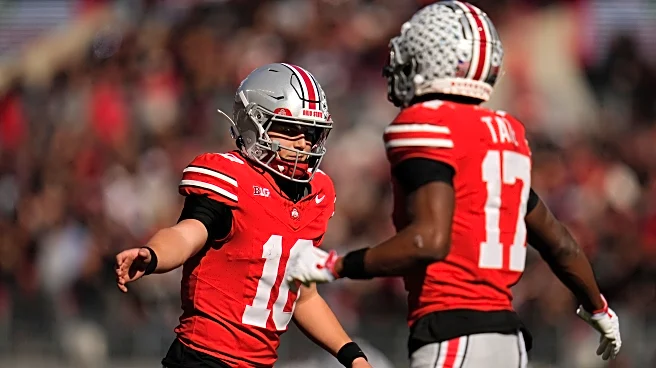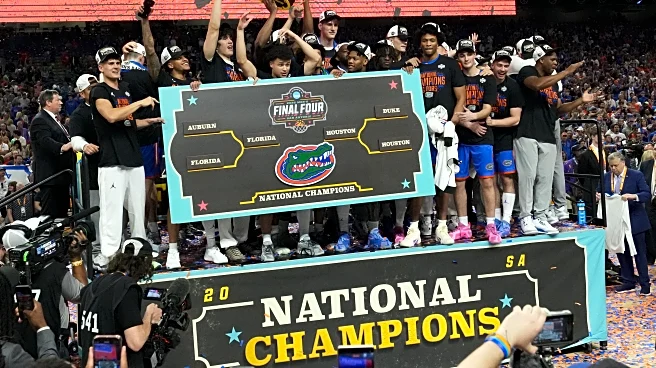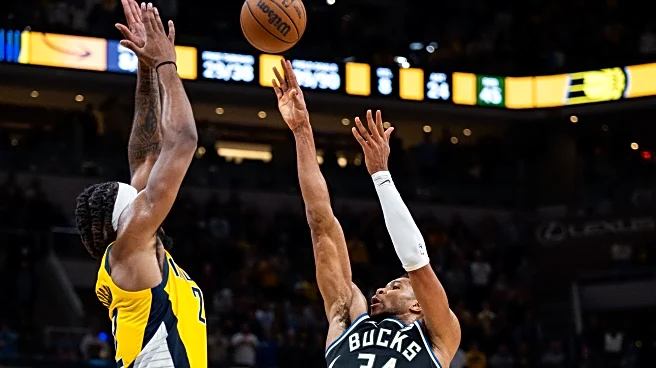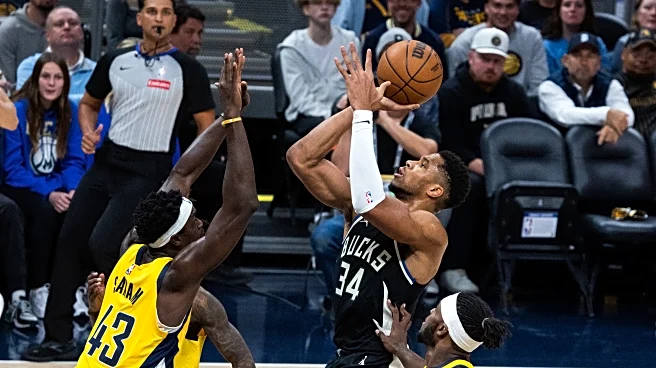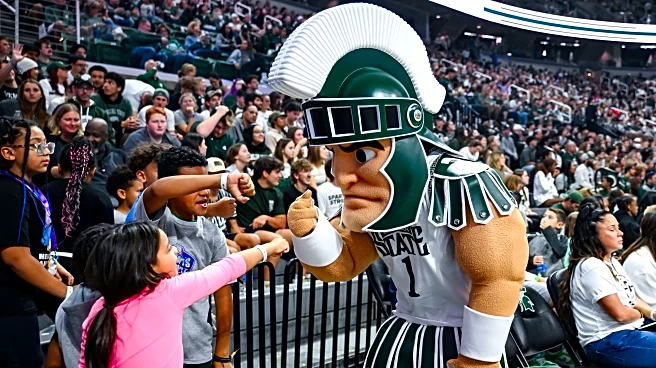The NBA has been back for a few weeks, but starting this week, basketball fans have a chance to see the league’s future in action as well. The college basketball season officially tipped off Monday. We’ve
received a taste of potential NBA stars in televised exhibition games the last few weeks, but now the games count. What better way to ring in the new season than to take a look at what each member of the Bucks roster accomplished in their collegiate years? Below are the stats of each Buck in their best collegiate season, and my rankings of each player’s college career. We’ve reached the time of the year when both the NBA and college basketball are in season—basketball fans rejoice!
Mark Sears: Ohio and Alabama
2023–24 season averages (with Alabama): 21.5 PPG, 4.2 RPG, 4.0 APG, 1.6 SPG
In terms of individual accolades, Sears had by far the best college career of any player on the Bucks roster. After two years at Ohio, he transferred to Alabama for his final three seasons. You could write a whole article about his awards and recognition, but the highlights include two-time All-American honors—First Team in 2024–25 and Second Team in 2023–24—a Bob Cousy Award finalist in 2023–24 and 2024–25, and a Naismith Player of the Year semifinalist in 2024–25. He also ranks 19th in Division I history with 2,841 career points. And if you’re more into team accomplishments, he has those too. In addition to a Sweet Sixteen and Elite Eight appearance in his first and third seasons with Alabama, respectively, he helped lead the Crimson Tide to the program’s first Final Four in 2024.
Bobby Portis: Arkansas
2014–15 season averages: 17.5 PPG, 8.9 RPG, 1.2 APG, 1.1 SPG, 1.4 BPG
Bobby played two seasons at Arkansas from 2013–15, earning notable individual honors in each season. In his freshman season, he made the SEC All-Freshman team and was second on the team in scoring. That same year, he earned Second-Team All-SEC honors—an impressive feat for a freshman. He exploded onto the national scene as a sophomore in 2014–15, leading Arkansas to the round of 32 and a final record of 27-9. In that season, Bobby was the SEC Player of the Year, First Team All-SEC, and a Second Team All-American
Andre Jackson Jr.: UConn
2022–23 season averages: 6.7 PPG, 4.7 APG, 6.2 RPG, 1.1 SPG
AJax is the only player on the current Bucks roster that holds national-champion status, so it felt wrong to let him fall any lower on this list, even if the individual numbers are less gaudy. He spent three years at UConn, notably starting 31 of the 36 games in the 2022–23 championship season. In that season, he was tied for the team lead in assists at 4.7 per game and often took on the defensive assignment of other teams’ best offensive player. Again, the numbers aren’t anything spectacular, but the assists and steals show how valuable he was to a team that rolled everyone en route to a championship, and that holds more weight than any individual accolade.
Gary Harris: Michigan State
2013–14 season averages: 16.7 PPG, 4.0 RPG, 2.7 APG, 1.8 SPG
On the banks of the Red Cedar, Harris had an extremely productive two seasons for Tom Izzo at Michigan State. In his freshman season, he made the Big Ten All-Freshman Team and won Big Ten Rookie of the Year. The Spartans advanced to the Sweet 16, with Harris playing a key role. His sophomore campaign, however, was even better. He saw an increase in most statistical categories, earned First Team All-Big Ten and Big Ten All-Defensive honors, and led Michigan State to the Elite Eight, where it fell to the eventual national champion UConn.
Taurean Prince: Baylor
2015–16 season averages: 15.9 PPG, 6.1 RPG, 2.3 APG, 1.3 SPG
To this day, it is a mystery how Yale outrebounded Baylor, but it is no mystery that Taurean Prince was a great college basketball player. Despite the upset loss that ended his career, Prince enjoyed some March Madness success as a key contributor to Baylor’s Sweet 16 run in 2014. Individually, he earned Second Team All-Big 12 honors and won the Big 12 Sixth Man of the Year award in 2015, and he earned First Team All-Big 12 honors his senior season. While the lasting college memory of Prince is his interview after losing to Yale, he had a more than satisfactory collegiate career.
AJ Green: Northern Iowa
2019–20 season averages: 19.7 PPG, 3.0 RPG, 3.0 APG
Dairy Bird never got his chance to steal the hearts of America in March Madness. In 2019–20, when Northern Iowa won the Missouri Valley Conference regular-season championship, they fell early in the conference tournament before the NCAA Tournament was later cancelled due to COVID. Still, AJ Green put together a strong individual career. In that 2019–20 season, he won the Missouri Valley Conference Player of the Year award, an honor he would again receive in the 2021–22 season. He started every game he played in college, averaging 17.9 points per game over four years in one of the toughest mid-major conferences. It’s a shame he never got a shot in the big dance, but the numbers and accolades still attest to an outstanding collegiate career.
Amir Coffey: Minnesota
2018–19 season averages: 16.6 PPG, 3.6 RPG, 3.2 APG
Coffey spent three seasons at Minnesota, contributing to the Golden Gophers’ success each season. As a freshman in 2016–17, he averaged 12.2 points, 3.8 rebounds, and 3.1 assists per game. Minnesota earned an NCAA Tournament berth that season as well. In his sophomore year, his stats were relatively similar, with a slight boost in scoring. For his final collegiate season, he saw another increase in scoring and maintained his rebounding and assist numbers, helping him earn Third Team All-Big Ten honors. Most importantly, he won a game in the 2019 NCAA Tournament, something Minnesota hadn’t done since 2013. Coffey instantly produced at the college level and did so for three seasons, enjoying team success along the way.
Kyle Kuzma: Utah
2016–17 season averages: 16.4 PPG, 9.3 RPG, 2.4 APG
Kuzma spent three seasons at Utah, experiencing both team and individual success. His freshman year, he played sparingly as the team made a run to the Sweet 16. In his sophomore season, he was a much more regular contributor, averaging better than 10 points per game on the season as the Utes advanced to the Round of 32. The Utes missed the tournament in his junior year, but he posted his best statistical season, allowing him to rise on draft boards en route to a first-round selection. With a balance of moderate team success and individual numbers, Kuzma can reflect on a productive college career.
Gary Trent Jr.: Duke
2017–18 season averages: 14.5 PPG, 4.2 RPG, 1.4 APG, 1.2 SPG
Trent played one season for a loaded Duke team. Marvin Bagley III looked like the next big thing in the frontcourt, and the backcourt was equally as stacked with Grayson Allen and Trevon Duval, who was thought to be a future star at the time. Despite the loaded roster, Gary carved out a role for himself similar to the one he’s played in the NBA. He shot 40% from 3-point range and averaged more than a steal per game. Given Duke’s talent level, his stat line is especially impressive, and despite being in college just one year, Duke’s success helps Trent above other one-and-dones on the Bucks.
Myles Turner: Texas
2014–15 season averages: 10.1 PPG, 6.5 RPG, 2.6 BPG
The Bucks’ major offseason addition played one collegiate season at Texas, where he enjoyed plenty of individual success. The team made the first round of the NCAA Tournament but lost. To no surprise, Turner was the Big 12 Freshman of the Year award winner after rejecting shots all season long. He also appeared on the Big 12 All-Defensive team and earned Third Team All-Big 12 honors. It was a brief stint in college for Turner, but he was very impactful—especially defensively—earning him a spot in the middle of the pack as far as college careers go for Bucks players.
Cole Anthony: North Carolina
2019–20 season averages: 18.5 PPG, 5.7 RPG, 4.0 APG, 1.3 SPG
Anthony entered his lone collegiate season with the weight of the world on his shoulders, being expected to lead a top-tier program in North Carolina to the promised land. The team did not fare well, posting a 14-19 final record. Anthony, however, still put together a nice season. As is the case with many freshmen, the efficiency struggles were abundant, but he also had more responsibility than most freshmen. Despite the team’s woes and his streaky shooting, Anthony made the All-ACC Rookie team and earned Third Team All-ACC honors. 2019–20 is a season North Carolina fans would like to forget, but given what was asked of Anthony, he had a decent season.
Ryan Rollins: Toledo
2021–22 season averages: 18.9 PPG, 6.0 RPG, 3.6 APG, 1.7 SPG
Ryan Rollins was an exceptional point guard at the mid-major level, but it’s hard to justify putting him higher on the list due to the level of competition and lack of team success. Still, in just two seasons, Rollins put together a decorated career at Toledo. In his freshman season, he won the MAC Rookie of the Year Award, and in his sophomore year, he was First Team All-MAC. The numbers speak for themselves—he did a little bit of everything for the Rockets, helping them win the conference regular-season crown in the 2021–22 season. While it was never enough to propel an underdog run on the national stage, his high-level production earned him a shot in the NBA.
Pete Nance: Northwestern and North Carolina
2021-22 season averages (with Northwestern): 14.6 PPG, 6.5 RPG, 2.7 APG, 1.1 BPG
Pete Nance is another guy on this list who never had a chance to shine in the NCAA Tournament. After the best statistical season of his career in 2021–22 at Northwestern, he transferred to North Carolina. The Tar Heels, fresh off a national championship appearance, wanted a stretch four to replace Brady Manek, who broke out during the tournament. Nance filled the role well, averaging double figures along with six rebounds and one block per game. Unfortunately, North Carolina struggled as a team and missed the tournament. While Nance didn’t get a chance to play in March Madness, he was a solid college player.
Jericho Sims: Texas
2019–20 season averages: 9.7 PPG, 8.2 RPG, 1.2 BPG
From his college tape, it’s easy to see why Sims had upside as an NBA prospect. In his four years at Texas, the Longhorns made the NCAA Tournament twice, losing in the first round both trips. Individually, Sims was as you’d expect based on his NBA career: a big who could jump out of the gym and used that athleticism to block shots and catch lobs. His college highlights are worth the watch, but simply put, he was a serviceable big man, and that isn’t enough to jump anyone ahead of him in this ranking.
Kevin Porter Jr.: USC
2018–19 season averages: 9.5 PPG, 4.0 RPG, 1.4 APG
KPJ rounds out the list, not because he had a bad collegiate tenure, but rather because USC wasn’t good in his lone season. He appeared in 21 games, making just four starts. He played his role well for the Trojans, coming off the bench as a spark plug who could score in bunches, and the numbers reflect that. He scored efficiently and did what was asked of him, but without eye-popping numbers or team success, it’s hard to justify him any higher on this list.
